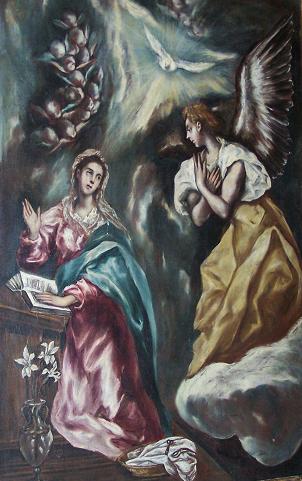Annunciation (El Greco, Sigüenza) facts for kids
Quick facts for kids Annunciation |
|
|---|---|
 |
|
| Artist | El Greco |
| Year | 1614 |
| Medium | oil on canvas |
| Dimensions | 152 cm × 99 cm (60 in × 39 in) |
| Location | Diocesan Museum, Sigüenza |
The Annunciation is a famous painting created in 1614 by the artist El Greco. You can find this artwork today in the Diocesan Museum in Sigüenza, Spain. It was one of the last paintings El Greco made. He likely worked on it with his son, Jorge Manuel.
Contents
What is the Annunciation?
The "Annunciation" is a very important event in Christian history. It describes the moment when the Archangel Gabriel visited the Virgin Mary. He told her that she would become the mother of Jesus Christ. This event is often shown in art, including many paintings.
Why is it called "Annunciation"?
The word "annunciation" means "to announce" or "to make a special announcement." In this case, it was the angel Gabriel announcing the news to Mary. Artists often show Gabriel with wings and Mary looking surprised or thoughtful.
Who was El Greco?
El Greco was a Greek painter, sculptor, and architect of the Spanish Renaissance. His real name was Doménikos Theotokópoulos. People called him "El Greco," which means "The Greek" in Spanish. He was born on the island of Crete in 1541.
El Greco's Journey as an Artist
El Greco first learned to paint icons in his home country. Later, he traveled to Venice, Italy. There, he studied with famous artists like Titian and Tintoretto. He learned about bright colors and dramatic lighting. After Italy, he moved to Spain in 1577. He spent most of his life in the city of Toledo.
El Greco's Unique Style
El Greco is known for his very special way of painting. His figures often look long and stretched out. They have dramatic poses and strong, bright colors. He used light in a unique way to create a spiritual feeling. His art is part of a style called Mannerism. This style came after the High Renaissance. It often showed things in a more emotional and less realistic way.
About the Painting
El Greco painted several versions of the Annunciation during his career. This particular version, from 1614, is one of his final works. It shows his mature style. The painting is made with oil paint on a canvas. It measures about 152 centimeters (about 5 feet) tall and 99 centimeters (about 3 feet) wide.
What Can You See in the Painting?
In the painting, you can see the Archangel Gabriel on the left. He is kneeling and pointing upwards. The Virgin Mary is on the right. She looks surprised or thoughtful. Above them, a dove, which represents the Holy Spirit, shines with bright light. There are also small angels or cherubs in the clouds.
Colors and Light
El Greco used a lot of bright, contrasting colors in this painting. You can see blues, reds, and yellows. The light in the painting seems to come from a divine source. It highlights the figures and creates a sense of movement and drama. This use of light and color helps to show the spiritual importance of the event.
Where is the Painting Now?
The Annunciation painting from 1614 is kept in the Diocesan Museum in Sigüenza, Spain. This museum is located in the city's cathedral. It holds many important religious artworks. The painting is a key piece in the museum's collection. It helps visitors understand El Greco's later artistic period.
See also
 In Spanish: La Anunciación (Sigüenza) para niños
In Spanish: La Anunciación (Sigüenza) para niños

